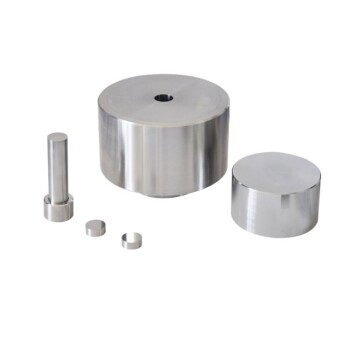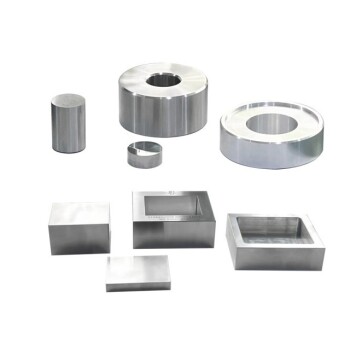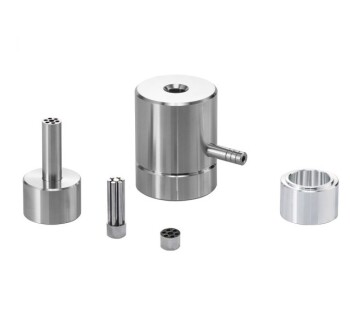In essence, Hot Isostatic Pressing (HIP) is a materials processing method that subjects a component to both high temperature and high, uniform gas pressure simultaneously. This combination is applied within a specialized vessel to compress materials, eliminate internal defects, and fundamentally improve their mechanical properties. The most common pressure medium is an inert gas like argon.
The critical insight is that HIP is not merely a compaction technique; it is a transformative healing process. It closes and welds shut the microscopic internal voids that act as failure points, thereby unlocking a material's full theoretical density and performance potential.
How Hot Isostatic Pressing Fundamentally Works
The effectiveness of HIP lies in its unique application of heat and uniform pressure to fundamentally alter a material's internal structure.
The Core Mechanism: Heat and Pressure
The process simultaneously applies extreme heat, often ranging from several hundred to over 2000°C, and intense isostatic pressure, from tens to 200 MPa.
The high temperature makes the material malleable on a microscopic level, allowing it to deform and flow under pressure.
The Role of the Inert Gas
This immense pressure is applied isostatically—meaning uniformly in all directions. This is achieved by using a high-pressure inert gas, most commonly argon.
Because the pressure is perfectly uniform, the part is densified without distorting its shape, unlike conventional pressing which uses a directional die.
Eliminating Internal Defects
The combination of heat and pressure causes internal pores, micro-cracks, and voids to collapse and permanently weld shut through a process of plastic deformation and diffusion bonding.
This removes the internal stress points where fatigue and fractures typically originate, effectively "healing" the material from the inside out.
The Tangible Benefits of Using HIP
Applying HIP moves a material from a standard-grade state to a high-performance one by creating an optimized internal structure.
Achieving Full Material Density
The primary outcome of HIP is the elimination of internal microporosity. This allows the component to reach nearly 100% of its theoretical maximum density.
Superior Mechanical Properties
By removing defects, HIP dramatically improves critical performance metrics. This results in significantly better fatigue life, ductility, impact strength, and toughness.
Creating a Uniform Microstructure
The process yields a material with a fine, uniform grain size. This isotropic structure ensures that the material's superior properties are consistent in every direction.
Understanding the Process Advantages and Comparisons
HIP offers unique capabilities compared to other manufacturing and densification methods, making it a crucial tool for advanced engineering.
HIP vs. Cold Isostatic Pressing (CIP)
The key distinction is heat. CIP uses only pressure at room temperature, typically to compact powders into a solid shape before a final heating step (sintering).
HIP, by contrast, uses both heat and pressure to achieve final densification and property enhancement in a single, definitive step.
Near-Net Shape Manufacturing
HIP can consolidate powders or densify castings into components that are very close to their final required dimensions. This is known as near-net shape manufacturing, which drastically reduces subsequent machining, material waste, and cost.
Process Consolidation and Efficiency
For certain alloys, the HIP cycle can be engineered to incorporate other heat treatment steps, such as aging or solution treating, into one operation. This consolidation enhances both manufacturing efficiency and final performance.
When to Specify Hot Isostatic Pressing
Your decision to use HIP should be driven by the performance requirements and nature of your application.
- If your primary focus is maximum reliability and fatigue life: Use HIP to eliminate internal defects in mission-critical cast or 3D-printed parts, such as aerospace turbine blades or medical implants.
- If your primary focus is creating high-performance powder metallurgy parts: Use HIP to consolidate metal, ceramic, or composite powders into a fully dense material with properties superior to those from conventional sintering.
- If your primary focus is manufacturing efficiency for complex shapes: Specify HIP to create near-net shape components, minimizing costly and time-consuming final machining operations.
By healing internal flaws at a microscopic level, Hot Isostatic Pressing allows you to engineer with the full, uncompromised potential of your chosen material.
Summary Table:
| Key Aspect | Description |
|---|---|
| Process | Applies high temperature and uniform gas pressure to eliminate internal defects like pores and micro-cracks. |
| Primary Benefits | Achieves near 100% density, improves fatigue life, ductility, impact strength, and toughness, and enables near-net shape manufacturing. |
| Common Applications | Aerospace turbine blades, medical implants, and high-performance powder metallurgy parts. |
| Pressure Medium | Inert gas, typically argon, for uniform isostatic pressure. |
Ready to enhance your laboratory's capabilities with advanced material processing? KINTEK specializes in lab press machines, including automatic lab presses, isostatic presses, and heated lab presses, designed to serve your needs for reliability and efficiency. Contact us today via our contact form to discover how our solutions can help you achieve superior material performance and reduce manufacturing costs!
Visual Guide

Related Products
- Automatic High Temperature Heated Hydraulic Press Machine with Heated Plates for Lab
- Heated Hydraulic Press Machine with Heated Plates for Vacuum Box Laboratory Hot Press
- Automatic Heated Hydraulic Press Machine with Hot Plates for Laboratory
- Heated Hydraulic Press Machine With Heated Plates For Vacuum Box Laboratory Hot Press
- Automatic Heated Hydraulic Press Machine with Heated Plates for Laboratory
People Also Ask
- How are heated hydraulic presses applied in the electronics and energy sectors? Unlock Precision Manufacturing for High-Tech Components
- How does a heated hydraulic press assist in thin film preparation? Achieve Uniform Films for Accurate Analysis
- How are heated hydraulic presses utilized in material testing and sample preparation? Enhance Your Lab's Precision and Efficiency
- What is a heated hydraulic press and what are its main components? Discover Its Power for Material Processing
- Why is a heated hydraulic press considered a critical tool in research and production environments? Unlock Precision and Efficiency in Material Processing



















